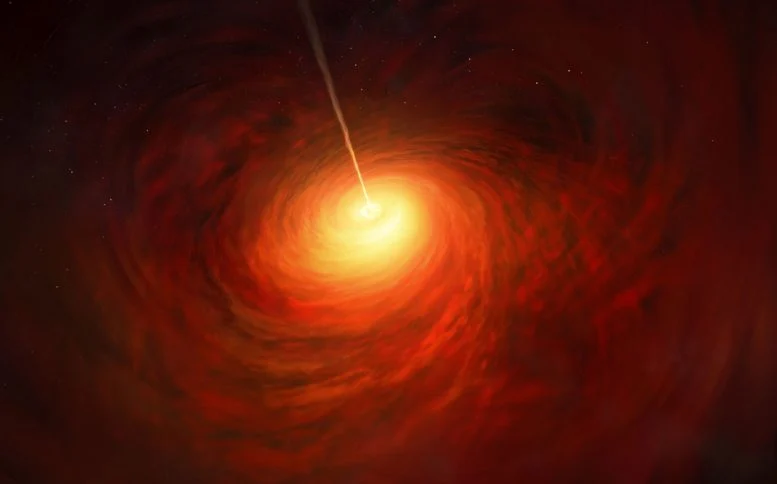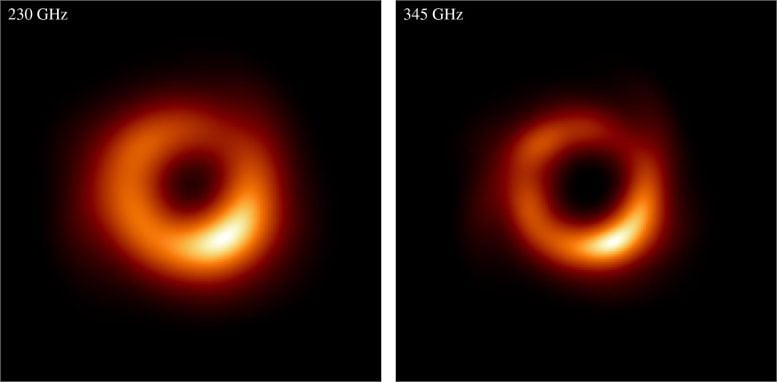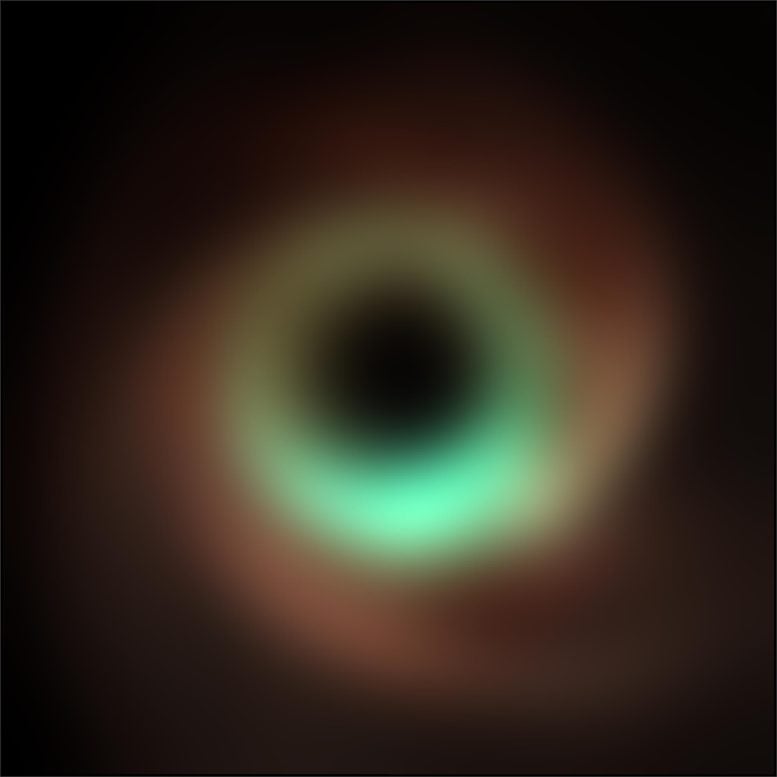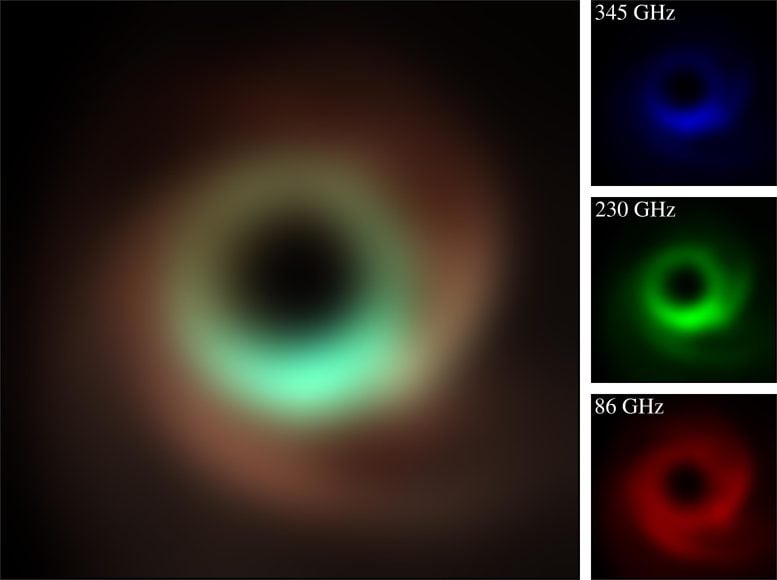
By Center for Astrophysics | Harvard & Smithsonian August 27, 2024
Collected at: https://scitechdaily.com/earths-most-powerful-telescope-captures-black-holes-in-unprecedented-detail/
The Event Horizon Telescope has achieved unprecedented high-resolution observations from Earth by utilizing the 345 GHz frequency, offering more detailed and color-enhanced images of black holes.
This advancement in the field of astrophysics leverages very-long-baseline interferometry to link multiple radio dishes globally, enhancing our understanding of the phenomena surrounding black holes and setting the stage for future high-fidelity visualizations and potentially real-time imaging of these cosmic entities.
Breakthrough in Black Hole Imaging
The Event Horizon Telescope (EHT) Collaboration has conducted test observations achieving the highest resolution ever obtained from the surface of the Earth, by detecting light from the centers of distant galaxies at a frequency of around 345 GHz.
When combined with existing images of supermassive black holes at the hearts of M87 and Sgr A at the lower frequency of 230 GHz, these new results will not only make black hole photographs 50% crisper but also produce multi-color views of the region immediately outside the boundary of these cosmic beasts.

Enhancements in Radio Astronomy
The new detections, led by scientists from the Center for Astrophysics | Harvard & Smithsonian (CfA) that includes the Smithsonian Astrophysical Observatory (SAO), were published today in The Astronomical Journal.
“With the EHT, we saw the first images of black holes by detecting radio waves at 230 GHz, but the bright ring we saw, formed by light bending in the black hole’s gravity still looked blurry because we were at the absolute limits of how sharp we could make the images,” said paper co-lead Alexander Raymond, previously a postdoctoral scholar at the CfA, and now at NASA’s Jet Propulsion Laboratory (NASA-JPL). “At 345 GHz, our images will be sharper and more detailed, which in turn will likely reveal new properties, both those that were previously predicted and maybe some that weren’t.”

Virtual Earth-Sized Telescope: The EHT’s Power Unleashed
The EHT creates a virtual Earth-sized telescope by linking together multiple radio dishes across the globe, using a technique called very-long-baseline interferometry (VLBI). To get higher-resolution images, astronomers have two options: increase the distance between radio dishes or observe at a higher frequency. Since the EHT was already the size of our planet, increasing the resolution of ground-based observations required expanding its frequency range, and that’s what the EHT Collaboration has now done.
”To understand why this is a breakthrough, consider the burst of extra detail you get when going from black and white photos to color,” said paper co-lead Sheperd “Shep” Doeleman, an astrophysicist at the CfA and SAO, and Founding Director of the EHT. “This new ‘color vision’ allows us to tease apart the effects of Einstein’s gravity from the hot gas and magnetic fields that feed the black holes and launch powerful jets that stream over galactic distances.”
A prism splits white light into a rainbow of colors because different wavelengths of light travel at different speeds through glass. But gravity bends all light similarly, so Einstein predicts that the size of the rings seen by the EHT should be similar at both 230 GHz and 345 GHz, while the hot gas swirling around the black holes will look different at these two frequencies.

Overcoming Technological Challenges in High-Frequency VLBI
This is the first time the VLBI technique has been successfully used at a frequency of 345 GHz. While the ability to observe the night sky with single telescopes at 345 GHz existed before, using the VLBI technique at this frequency has long presented challenges that took time and technological advances to overcome. Water vapor in the atmosphere absorbs waves at 345 GHz much more than at 230 GHz weakening the signals from black holes at the higher frequency. The key was to improve the sensitivity of the EHT, which the researchers did by increasing the bandwidth of the instrumentation and waiting for good weather at all sites.

Global Collaboration and Cutting-Edge Technology
The new experiment used two small subarrays of the EHT—made up of the Atacama Large Millimeter/submillimeter Array (ALMA) and the Atacama Pathfinder EXperiment (APEX) in Chile, the IRAM 30-meter telescope in Spain, the NOrthern Extended Millimeter Array (NOEMA) in France, the Submillimeter Array (SMA) on Maunakea in Hawaiʻi, and the Greenland Telescope—to make measurements with resolution as fine as 19 microarcseconds.
“The most powerful observing locations on Earth exist at high altitudes, where atmospheric transparency and stability is optimal but weather can be more dramatic,” said Nimesh Patel, an astrophysicist at the CfA and SAO, and a project engineer at SMA, adding that at the SMA, the new observations required braving icy roads at Maunakea to open the array in the stable weather after a snow storm with minutes to spare. “Now, with high-bandwidth systems that process and capture wider swaths of the radio spectrum, we are starting to overcome basic problems in sensitivity, like weather. The time is right, as the new detections prove, to advance to 345 GHz.”
Future of Black Hole Imaging: The ngEHT Project
This achievement also provides another stepping stone on the path to creating high-fidelity movies of the event horizon environment surrounding black holes, which will rely on upgrades to the existing global array. The planned next-generation EHT (ngEHT) project will add new antennas to the EHT in optimized geographical locations and enhance existing stations by upgrading them all to work at multiple frequencies between 100 GHz and 345 GHz at the same time. As a result of these and other upgrades, the global array is expected to increase the amount of sharp, clear data EHT has for imaging by a factor of 10, enabling scientists to not only produce more detailed and sensitive images but also movies starring these violent cosmic beasts.
A Major Milestone in Astrophysical Research
“The EHT’s successful observation at 345 GHz is a major scientific milestone,” said Lisa Kewley, Director of CfA and SAO. “By pushing the limits of resolution, we’re achieving the unprecedented clarity in the imaging of black holes we promised early on, and setting new and higher standards for the capability of ground-based astrophysical research.”
For more on this breakthrough, see High-Frequency Observations Reveal Black Holes Like Never Before.
Reference: “First Very Long Baseline Interferometry Detections at 870 μm” by Alexander W. Raymond, Sheperd S. Doeleman, Keiichi Asada, Lindy Blackburn, Geoffrey C. Bower, Michael Bremer, Dominique Broguiere, Ming-Tang Chen, Geoffrey B. Crew, Sven Dornbusch, Vincent L. Fish, Roberto García, Olivier Gentaz, Ciriaco Goddi, Chih-Chiang Han, Michael H. Hecht, Yau-De Huang, Michael Janssen, Garrett K. Keating, Jun Yi Koay, Thomas P. Krichbaum, Wen-Ping Lo, Satoki Matsushita, Lynn D. Matthews, James M. Moran, Timothy J. Norton, Nimesh Patel, Dominic W. Pesce, Venkatessh Ramakrishnan, Helge Rottmann, Alan L. Roy, Salvador Sánchez, Remo P. J. Tilanus, Michael Titus, Pablo Torne, Jan Wagner, Jonathan Weintroub, Maciek Wielgus, André Young, Kazunori Akiyama, Ezequiel Albentosa-Ruíz, Antxon Alberdi, Walter Alef, Juan Carlos Algaba, Richard Anantua, Rebecca Azulay, Uwe Bach, Anne-Kathrin Baczko, David Ball, Mislav Balokovic, Bidisha Bandyopadhyay, John Barrett, Michi Bauböck, Bradford A. Benson, Dan Bintley, Raymond Blundell, Katherine L. Bouman, Hope Boyce, Roger Brissenden, Silke Britzen, Avery E. Broderick, Thomas Bronzwaer, Sandra Bustamante, John E. Carlstrom, Andrew Chael, Chi-kwan Chan, Dominic O. Chang, Koushik Chatterjee, Shami Chatterjee, Yongjun Chen, Xiaopeng Cheng, Ilje Cho, Pierre Christian, Nicholas S. Conroy, John E. Conway, Thomas M. Crawford, Alejandro Cruz-Osorio, Yuzhu Cui, Rohan Dahale, Jordy Davelaar, Mariafelicia De Laurentis, Roger Deane, Jessica Dempsey, Gregory Desvignes, Jason Dexter, Vedant Dhruv, Indu K. Dihingia, Sergio A. Dzib, Ralph P. Eatough, Razieh Emami, Heino Falcke, Joseph Farah, Edward Fomalont, Anne-Laure Fontana, H. Alyson Ford, Marianna Foschi, Raquel Fraga-Encinas, … , Feryal Özel, Daniel C. M. Palumbo, Georgios Filippos Paraschos, Jongho Park, Harriet Parsons, Ue-Li Pen, Vincent Piétu, Aleksandar PopStefanija, Oliver Porth, Ben Prather, Giacomo Principe, Dimitrios Psaltis, Hung-Yi Pu, Philippe A. Raffin, Ramprasad Rao, Mark G. Rawlings, Angelo Ricarte, Bart Ripperda, Freek Roelofs, Cristina Romero-Cañizales, Eduardo Ros, Arash Roshanineshat, Ignacio Ruiz, Chet Ruszczyk, Kazi L. J. Rygl, David Sánchez-Argüelles, Miguel Sánchez-Portal, Mahito Sasada, Kaushik Satapathy, Tuomas Savolainen, F. Peter Schloerb, Jonathan Schonfeld, Karl-Friedrich Schuster, Lijing Shao, Zhiqiang Shen, Des Small, Bong Won Sohn, Jason SooHoo, León David Sosapanta Salas, Kamal Souccar, Joshua S. Stanway, He Sun, Fumie Tazaki, Alexandra J. Tetarenko, Paul Tiede, Kenji Toma, Teresa Toscano, Efthalia Traianou, Tyler Trent, Sascha Trippe, Matthew Turk, Ilse van Bemmel, Huib Jan van Langevelde, Daniel R. van Rossum, Jesse Vos, Derek Ward-Thompson, John Wardle, Jasmin E. Washington, Robert Wharton, Kaj Wiik, Gunther Witzel, Michael F. Wondrak, George N. Wong, Qingwen Wu, Nitika Yadlapalli, Paul Yamaguchi, Aristomenis Yfantis, Doosoo Yoon, Ziri Younsi, Wei Yu, Feng Yuan, Ye-Fei Yuan, J. Anton Zensus, Shuo Zhang, Guang-Yao Zhao and Shan-Shan Zhao, 27 August 2024, The Astronomical Journal.
DOI: 10.3847/1538-3881/ad5bdb

Leave a Reply